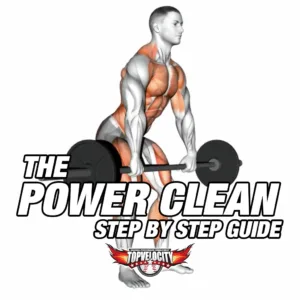 The power clean is a dynamic compound exercise that enhances explosive power, a critical component for athletes, especially in baseball. It's a cornerstone lift that can contribute significantly to a player's performance on the field. This comprehensive guide is designed to help beginners master the power clean technique, ensuring safety and effectiveness in their training regimen.
The power clean is a dynamic compound exercise that enhances explosive power, a critical component for athletes, especially in baseball. It's a cornerstone lift that can contribute significantly to a player's performance on the field. This comprehensive guide is designed to help beginners master the power clean technique, ensuring safety and effectiveness in their training regimen.
The power clean is an Olympic weightlifting movement that targets multiple muscle groups, including the hamstrings, glutes, quads, lower and upper back, deltoids, and arms. It's a complex lift that involves moving a barbell from the floor to a racked position across the deltoids and clavicles in one fluid motion.
The Multifaceted Benefits of Power Clean
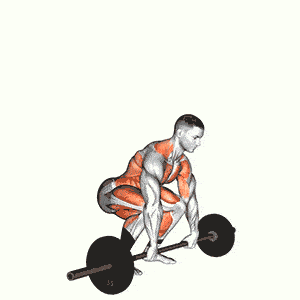
The power clean is more than just a lift; it's a comprehensive movement that builds a foundation for athletic prowess across various sports. While it's particularly beneficial for baseball players, enhancing the explosive strength necessary for sprinting to bases, leaping for catches, and powering through throws, its advantages extend far beyond the diamond.
For Other Sports: Power Clean
- Basketball: Athletes can improve their vertical jump height, a critical skill for rebounding and shot-blocking.
- Football: Players benefit from increased explosive power for tackles, sprints, and starts from a stationary position.
- Track and Field: Sprinters and jumpers can develop the rapid force production essential for their events.
- Volleyball: Improved explosive power aids in spiking and blocking.
- Soccer: Players enhance their ability to perform quick sprints and powerful kicks.
The power clean teaches the body to recruit muscle fibers rapidly and efficiently, which is crucial for any sport requiring sudden bursts of speed or power. It's not just about strength; it's about speed-strength, the ability to exert maximal force in minimal time.
For General Health and Fitness: Power Clean
The benefits of the power clean also translate to general health and fitness. Here's how:
- Functional Strength: The power clean develops functional strength by mimicking natural movement patterns, which can make everyday activities easier and reduce the risk of injury.
- Muscle Coordination: It requires and enhances coordination, timing, and motor control, which are essential for maintaining an active lifestyle.
- Metabolic Boost: This exercise is metabolically demanding, which can help in burning calories and improving cardiovascular health.
- Bone Density: Weight-bearing exercises like the power clean can increase bone density, which is vital for preventing osteoporosis.
- Posture and Core Stability: The lift engages the core muscles, which can lead to improved posture and core stability.
A Holistic Approach to Athletic Training
Incorporating power cleans into a training program provides a holistic approach to developing an athlete. It's not just about the muscles; it's also about the nervous system. The power clean conditions the neuromuscular pathways to fire more rapidly, which can translate to better performance in any sport or physical activity.
Moreover, the power clean can be a benchmark for overall athleticism. It requires and develops a combination of strength, speed, coordination, and balance. These attributes are essential not only in competitive sports but also in the pursuit of a healthy and active lifestyle.
Getting Started: Power Clean
Before attempting the power clean, it's crucial to have a solid foundation of strength and to be comfortable with basic lifts like the deadlift and squat. Ensure you're performing the exercise in a safe environment, ideally with bumper plates and on a lifting platform.
Step-by-Step Power Clean Technique
Step 1: The Setup
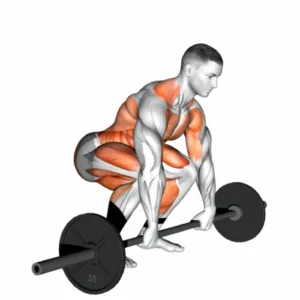
- Stand with your feet hip-width apart, with the barbell over your toes.
- Bend at the hips and knees to grip the bar just outside your legs.
- Your back should be flat, with shoulders slightly in front of the bar.
- Arms are straight, and the chest is up.
Step 2: The First Pull
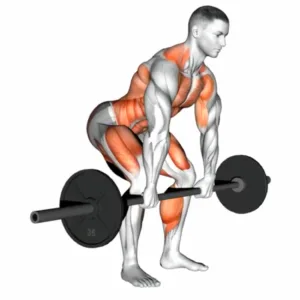
- Begin the lift by driving through the heels.
- Keep the bar close to your body.
- Extend your legs while your back angle remains constant.
- The bar should travel vertically, close to your shins.
Step 3: The Transition (Scoop)
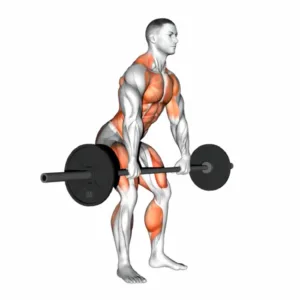
- As the bar passes the knees, transition into a scooping motion.
- Shift your knees forward slightly, keeping the bar close.
- This positions the body for the explosive second pull.
Step 4: The Second Pull (Explosion)
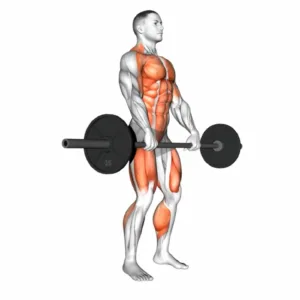
- Explosively extend the hips, knees, and ankles (triple extension).
- Shrug your shoulders to add momentum to the bar.
- Keep the bar close to your body as it travels upward.
Step 5: The Catch
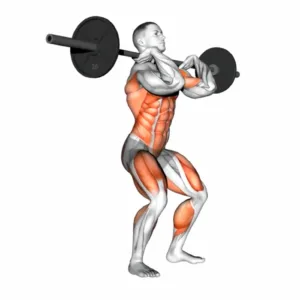
- As the bar reaches its highest point, quickly drop under it.
- Rotate your elbows forward to catch the bar across the front of your shoulders.
- Absorb the weight by bending the knees and dropping into a partial front squat.
Step 6: The Recovery
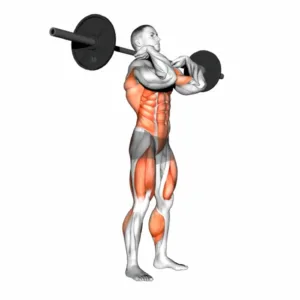
- Stand up by driving through the heels.
- Keep the torso upright and the bar racked on the shoulders.
- Reset and prepare for the next repetition.
Common Mistakes and Corrections: Power Clean
- Rounding the back: Maintain a neutral spine throughout the lift.
- Pulling with the arms too early: Focus on the leg drive and hip extension before using the arms.
- Catching the bar with straight legs: Ensure you're catching in a partial squat to absorb the weight.
Training Tips: Power Clean
- Start with light weights to focus on form.
- Perform the power clean early in your workout when you're fresh.
- Aim for 3-5 sets of 3-5 reps, focusing on explosive power rather than endurance.
Male Power Clean Standards (lb)
Power Clean By Age
Power Clean By Bodyweight
Starting Out: Benchmarks for Beginners
When you're new to the power clean, it's important to set realistic and safe goals. For a male beginner, lifting approximately 102 pounds (1RM - one-rep max) is a solid starting point. This level of strength is commendable, especially when compared to the average untrained individual.
Progressing to Intermediate Levels
As you gain experience and strength, the power clean numbers typically increase. An intermediate lifter can often handle a power clean of around 202 pounds (1RM). Achieving this demonstrates a significant commitment to training and places you at a strength level that's considered robust among gym-goers.
What Does the Average Look Like?
On average, a male lifter can power clean 202 pounds (1RM). This figure is a benchmark for intermediate lifters and is indicative of a well-developed level of strength and technique.
Defining a Strong Power Clean
What constitutes a "good" power clean can vary based on several factors, including age, weight, and experience. However, for male beginners, a one-rep max of 102 pounds is a noteworthy achievement. It's a testament to one's dedication to improving physical strength and mastering the technique required for this dynamic lift.
FAQs
Q: What is a Power Clean? A: A Power Clean is a compound Olympic weightlifting movement that involves lifting a barbell from the floor to a racked position across the deltoids and clavicles in one fluid motion.
Q: Why is the Power Clean beneficial? A: The Power Clean builds explosive power, improves athletic performance, and increases strength and coordination. It's beneficial not just for weightlifters but for athletes across various sports, as well as for general fitness enthusiasts.
Q: How do I know if I'm a beginner, novice, intermediate, advanced, or elite lifter? A: Your classification depends on the amount of weight you can lift relative to your body weight and experience level. This article provides standards that categorize lifters based on their one-rep max (1RM) in relation to their body weight.
Q: Can I perform Power Cleans without prior experience? A: It's recommended to have a basic level of strength and to learn the proper technique under the guidance of a certified trainer to prevent injury.
Q: How often should I perform Power Cleans? A: The frequency can vary based on your overall training program, goals, and recovery. Typically, incorporating Power Cleans 1-2 times per week is sufficient for most athletes.
Q: What should I do if I can't lift the beginner standard weight? A: Start with a weight that is comfortable for you and focus on proper form. Gradually increase the weight as you become stronger and more confident in the movement.
Q: Are there age-specific standards for Power Cleans? A: Yes, this article provides standards based on age and body weight to help you understand where you stand relative to others in your age group.
Q: Is it necessary to reach the 'elite' standard to be considered strong? A: Not at all. 'Elite' standards are typically for top-level athletes. Being at any level above beginner shows that you have developed significant strength and technique.
Q: How can I improve my Power Clean? A: Improving your Power Clean involves consistent practice, focusing on technique, and incorporating strength and conditioning exercises that complement the movement.
Q: Are Power Cleans safe for teenagers? A: Yes, with proper supervision, technique, and appropriate weights, Power Cleans can be safe and beneficial for teenagers.
Q: Can Power Cleans help with weight loss? A: Power Cleans are a high-intensity exercise that can contribute to weight loss as part of a balanced exercise regimen and diet.
Q: Do I need special equipment to perform Power Cleans? A: You'll need a barbell and weight plates. It's also recommended to use a lifting platform and proper footwear to ensure safety.
Q: Can I substitute Power Cleans with another exercise? A: While Power Cleans are unique, there are other exercises like deadlifts, squats, and Olympic lifts that can also develop explosive power and strength.



